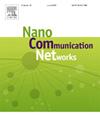High-speed and area-efficient arithmetic and logic unit architecture using quantum-dot cellular automata for digital signal processing
IF 4.7
4区 计算机科学
Q2 ENGINEERING, ELECTRICAL & ELECTRONIC
引用次数: 0
Abstract
Signal processing has significantly influenced our lives in many domains, including telecommunications, education, healthcare, industry, and security. The efficiency of signal processing heavily relies on the Arithmetic and Logic Unit (ALU), which stands as an essential hardware component. In addition, ALU is a fundamental part of a central processing unit (CPU), leading to fundamental operations inside the processor. However, the growing demand for small, robust hardware systems has led researchers to create nano-electronic technologies under consideration. One of the leading technologies in this field is Quantum-dot cellular automata (QCA), which demonstrates promising value as a possible alternative to complementary metal-oxide-semiconductor (CMOS) designs since it enables compact circuit designs with minimal power consumption. The existing QCA-based ALU designs face limitations in cell count density together with high occupied area and high delay, which reduces their performance for real-time signal processing. This research presents a 1-bit ALU through a QCA-optimized approach for DSP applications. QCADesigner is used to validate and verify all proposed designs. Results show a statistically significant improvement in cell count reduction of 46.84 % and a total occupied area of 64.28 % lower than the most advanced version published to date.
利用量子点元胞自动机进行数字信号处理的高速和面积有效的算术和逻辑单元体系结构
信号处理在许多领域显著地影响着我们的生活,包括电信、教育、医疗保健、工业和安全。信号处理的效率在很大程度上依赖于算术逻辑单元(ALU),它是必不可少的硬件部件。此外,ALU是中央处理器(CPU)的基本组成部分,导致处理器内部的基本操作。然而,对小型、坚固的硬件系统日益增长的需求使得研究人员正在考虑创建纳米电子技术。该领域的领先技术之一是量子点元胞自动机(QCA),它作为互补金属氧化物半导体(CMOS)设计的可能替代品显示出有希望的价值,因为它可以以最小的功耗实现紧凑的电路设计。现有基于qca的ALU设计存在小区数密度受限、占用面积大、时延高等问题,降低了ALU的实时信号处理性能。本研究通过qca优化方法为DSP应用提供了一个1位ALU。qcaddesigner用于验证和验证所有提议的设计。结果表明,与迄今为止发表的最先进版本相比,该版本的细胞计数减少了46.84%,总占地面积减少了64.28%。
本文章由计算机程序翻译,如有差异,请以英文原文为准。
求助全文
约1分钟内获得全文
求助全文
来源期刊

Nano Communication Networks
Mathematics-Applied Mathematics
CiteScore
6.00
自引率
6.90%
发文量
14
期刊介绍:
The Nano Communication Networks Journal is an international, archival and multi-disciplinary journal providing a publication vehicle for complete coverage of all topics of interest to those involved in all aspects of nanoscale communication and networking. Theoretical research contributions presenting new techniques, concepts or analyses; applied contributions reporting on experiences and experiments; and tutorial and survey manuscripts are published.
Nano Communication Networks is a part of the COMNET (Computer Networks) family of journals within Elsevier. The family of journals covers all aspects of networking except nanonetworking, which is the scope of this journal.
 求助内容:
求助内容: 应助结果提醒方式:
应助结果提醒方式:


